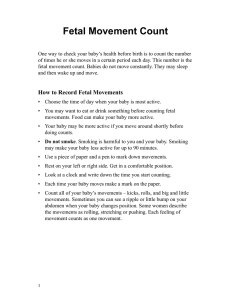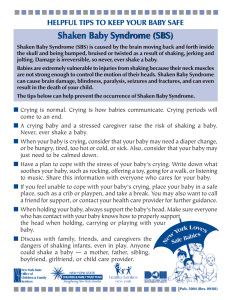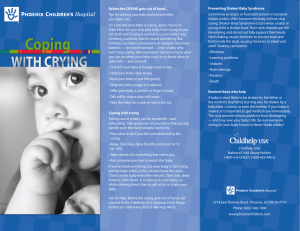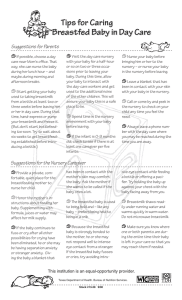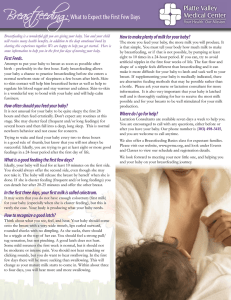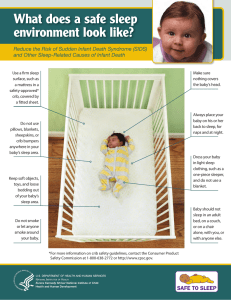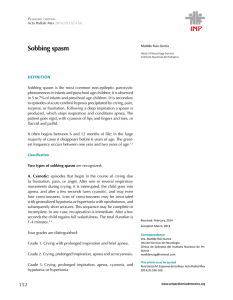Why Is My Baby Crying So Much?
Anuncio
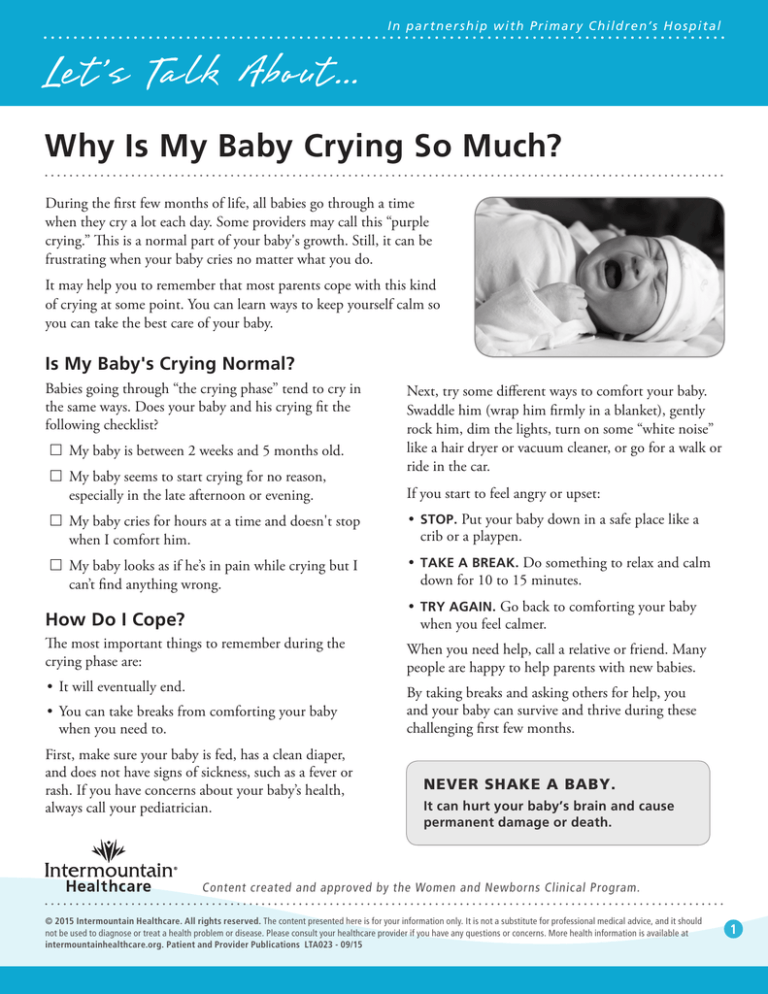
I n p ar t n e r ship w i t h P r imar y Child r e n’s H os pi t al Why Is My Baby Crying So Much? During the first few months of life, all babies go through a time when they cry a lot each day. Some providers may call this “purple crying.” This is a normal part of your baby's growth. Still, it can be frustrating when your baby cries no matter what you do. It may help you to remember that most parents cope with this kind of crying at some point. You can learn ways to keep yourself calm so you can take the best care of your baby. Is My Baby's Crying Normal? Babies going through “the crying phase” tend to cry in the same ways. Does your baby and his crying fit the following checklist? My baby is between 2 weeks and 5 months old. My baby seems to start crying for no reason, especially in the late afternoon or evening. Next, try some different ways to comfort your baby. Swaddle him (wrap him firmly in a blanket), gently rock him, dim the lights, turn on some “white noise” like a hair dryer or vacuum cleaner, or go for a walk or ride in the car. If you start to feel angry or upset: My baby cries for hours at a time and doesn't stop when I comfort him. •• STOP. Put your baby down in a safe place like a crib or a playpen. My baby looks as if he’s in pain while crying but I can’t find anything wrong. •• TAKE A BREAK. Do something to relax and calm down for 10 to 15 minutes. How Do I Cope? •• TRY AGAIN. Go back to comforting your baby when you feel calmer. The most important things to remember during the crying phase are: When you need help, call a relative or friend. Many people are happy to help parents with new babies. •• It will eventually end. By taking breaks and asking others for help, you and your baby can survive and thrive during these challenging first few months. •• You can take breaks from comforting your baby when you need to. First, make sure your baby is fed, has a clean diaper, and does not have signs of sickness, such as a fever or rash. If you have concerns about your baby’s health, always call your pediatrician. NEVER SHAKE A BABY. It can hurt your baby’s brain and cause permanent damage or death. Content created and approved by the Women and Newborns Clinical Program. © 2015 Intermountain Healthcare. All rights reserved. The content presented here is for your information only. It is not a substitute for professional medical advice, and it should not be used to diagnose or treat a health problem or disease. Please consult your healthcare provider if you have any questions or concerns. More health information is available at intermountainhealthcare.org. Patient and Provider Publications LTA023 - 09/15 1 ¿Por qué llora tanto mi bebé? Durante los primeros meses de vida, todos los bebés pasan por un momento en el que lloran mucho todos los días. Algunos proveedores pueden llamarle a este periodo “de llanto inconsolable”. Es una parte normal del crecimiento de su bebé. Sin embargo, puede ser frustrante cuando su bebé llora sin importar lo que usted haga. Puede ser útil recordar que la mayoría de los padres hacen frente a este tipo de llanto en algún momento. Usted puede aprender formas de mantener la calma para que pueda dar el mejor cuidado a su bebé. ¿El llanto de mi bebé es normal? Los bebés que están pasando por la “etapa de llanto” tienden a llorar de la misma manera. ¿Su bebé y su llanto encajan en la siguiente lista de verificación? Mi bebé tiene entre dos semanas y cinco meses de nacido. Mi bebé parece comenzar a llorar sin razón alguna, especialmente al caer la tarde o en la noche. Mi bebé llora por horas a la vez y no deja de llorar cuando lo consuelo. Parece que le doliera algo a mi bebé cuando llora, pero no puedo encontrarle nada mal. ¿Cómo le puedo hacer frente? Las cosas más importantes de recordar durante la etapa de llanto son: •• Con el tiempo terminará. •• Usted puede tomar los descansos que necesite cuando consuele a su bebé. Primordialmente, asegúrese de que su bebé haya comido, tenga un pañal limpio y no tenga síntomas de enfermedad, como fiebre o sarpullido. Siempre llame al pediatra si está preocupado sobre la salud de su bebé. Posteriormente, intente diferentes maneras de reconfortarlo. Envuelva a su bebé firmemente en una cobija y mézalo suavemente, atenúe las luces, prenda un poco de “ruido blanco” como un secador de pelo o una aspiradora, o vaya a una caminata o a un paseo en coche. Si usted empieza a sentirse enojado o molesto: •• DETÉNGASE. Ponga a su bebé en un lugar seguro como en una cuna o en un corralito. •• TOME UN DESCANSO. Haga algo para relajarse y cálmese durante diez a quince minutos. •• INTÉNTELO NUEVAMENTE. Vuelva a consolar a su bebé cuando usted sienta más calma. Cuando necesite ayuda, llame a un familiar o amigo; muchas personas tienen disposición y les da gusto ayudar a los nuevos padres. Al tomar descansos y pedir la ayuda de otros, su bebé y usted pueden superar estos pocos meses, los cuales pueden llegar a ser difíciles. NUNCA SACUDA A UN BEBÉ. Esto puede dañar el cerebro del infante y causar daños permanentes o incluso la muerte. El contenido fue creado y aprobado por el programa clínico para mujeres y recién nacidos. © 2015 Intermountain Healthcare. Todos los derechos reservados. El contenido del presente folleto tiene solamente fines informativos. No sustituye los consejos profesionales de un médico; tampoco debe utilizarse para diagnosticar o tratar un problema de salud o enfermedad. Si tiene cualquier duda o inquietud, no dude en consultar a su proveedor de cuidados de la salud. Hay más información disponible en intermountainhealthcare.org. Patient and Provider Publications LTA023S - 09/15 (Spanish translation 12/15 by Lingotek, Inc.) 2



